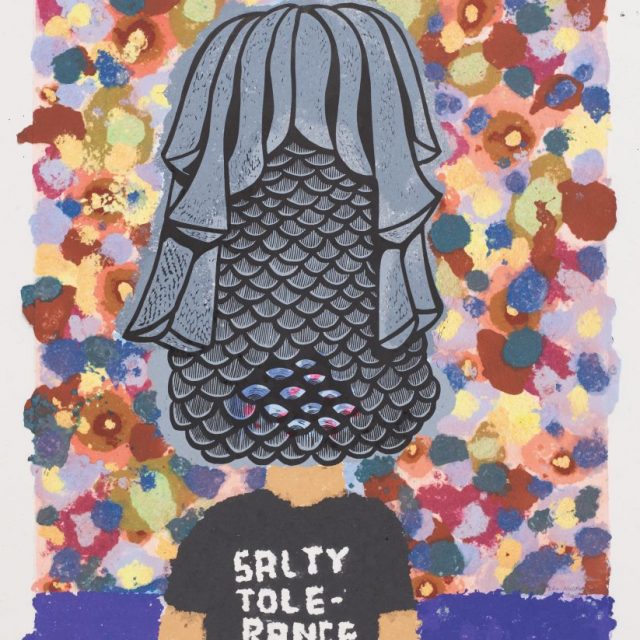The Masks of Eko Nugroho

Yogyakarta-born and based Eko Nugroho is renowned for his trade mark investigations into social constructs and human behaviour under conditions of concealed identity: the faces of people he candidly depicts in his artwork are always completely hidden under elaborate masks, regardless of whether he is working on a painting, a sculpture, an embroidered tapestry, animation or comics.
He draws inspiration to indulge in such concealment from the Indonesian fascination with being masked. And his vivid face masks play a crucial role in defining his social-political commentary on Indonesia’s economic and political reforms in the 1990s that were closely tied to the downfall of Suharto’s tyrannical reign.
His “It’s All About Coalition”, at the Singapore Art Museum, is one such definitive example. In this sculpture of 2 people facing each other, machine parts and unidentifiable objects totally hide their heads. This immediately transforms the 2 figures before us into you, I, the artist Nugroho, every man and the other all at once. And we are all feeling protected and concealed while being detached, isolated or even indifferent as we approach each other for the universal gesture of a hand shake.
But the out-stretched hand of one person is in the form of a vicious snarling wolf’s head and an ominous claw for the other. Thus, Nugroho raises the question of whether a true coalition can arise as Indonesia pushes for a stronger democracy and civilian rule as elements of the military tries to retain their influence and the Islamic fraction in politics grow while the country’s different regions demand for greater regional autonomy.
Then there is his 3-panelled painting “Big Country, Narrow Mindset”: the human figures are masked by robotic- and alien-like heads; giving them license to be ominously caught up in a seemingly apocalyptic scene of violent and hostile chaos and terror. Its equally masked hero has “I’m Not Yours” printed on his chest; thus defiantly indicating his rebellion against the status quo embroidered in a landscape of narrow-mindedness that could lead to self-destruction.
This theme of the masked hero, so commonly used in comic strips around the world, gamely crops up again in Nugroho’s embroidery, “Illusion”. Here his hooded figure resembles an astronaut and he has returned home to find an environment depleted of its greenery and all forms of life by monster-like machines: the sterile environmentally destroyed landscape left is a harsh, jagged terrain, exposed to the dangers of over-heating and crisping up.
By having his astronaut keep his hood on, Nugroho succeeds in emphasizing that this scene could be faced by anyone of us – if we do not do enough to safeguard the environment we have.
In his upcoming solo exhibition, “We Are What We Mask”, at the Singapore Tyler Print Institute (STPI), Nugroho continues to hide identities behind masks or machine parts boldly patterned with traditional Indonesian art forms like batik and embroidery. In this case, to challenge us to ‘think about what it means to be an individual’ and ‘what makes up our identities’.
The forms they imaginatively take liberally draw avid inspiration from Mexican Lucha Libre wrestling masks, the Islamic head-dresses, bio-hazard protective head-gear and his ever-enduring comic-inspired masked characters from works like the ones mentioned above.
Because this exhibition arises from his recent residency at STPI, the artworks that result are a personal response to the culture and society he experienced in Singapore: they illustrate his impression of Singaporean identities and the individuals he met here, as well as the places he had visited and the situations and accompanying issues he had found himself in.
The colourful, and almost playful, eclectic mix of 2- and 3-dimensional alien-like masks, with names like “Faith in Shopping” and “While Money Is In Our Hands, There Will Be Hope In Our Dreams”, draw upon the quintessential Singaporean excesses of consumer culture – one Nugroho fervently believes is shared by the equally pragmatic Indonesians.
As for the nasty faces of individuals he had met here, he cheekily transforms into jovial but more austere hoods with telling names like “I Am Animal of My Own Destiny” and “Monster on Us”.
Yet, by whatever form these Singaporean masks may take, they make the point on the dual identities of man and how the everyday pressures of life on this little red dot under the sun push us to conform by suppressing our own individuality. By so doing, they make us ask, ‘Are we the masks we wear or the one that is masked?’
And this point is as pertinent outside of our little tropical island – Nugroho too ‘feel(s) culturally programmed within (his) own Javanese identity’: he is equally compelled ‘to be refined and polite, to be a certain mold – and not truly be… able to express how (he) feel(s)’.
See if you agree with Nugroho’s depiction of all of us: the “We Are What We Mask” exhibition will be held at the Singapore Tyler Print Institute, at 41 Robertson Quay, Singapore 238236 from 7 September to 9 October this year.
To get a more comprehensive insight into Nugroho’s artistic repertoire, include in your fact finding outing his artworks displayed in the Singapore Art Museum, which is located at 71 Bras Basah Road, Singapore 189555. This engaging exhibition on “People and Places” ends 31 December 2013.
 Singart
Singart
